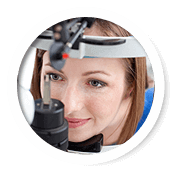The function of your tears is to nourish, protect and lubricate the cornea of your eye and keep you comfortable. When the tear film becomes deficient in quantity and / or in quality, dry eye symptoms result.
About the Tear Film
The tear film is composed of three layers. The outer one is the oily layer which is produced by the meibomian glands located in the eyelids, it prevents the evaporation of the 2 other tear film layers and keeps the surface smooth. The middle layer is primarily made of water and is produced by the lacrimal gland located within the orbit above the lateral end of the eye, and helps to maintain the eye clean by washing foreign particles away. The inner layer is a mcucus layer produced by goblet cells from the conjunctiva, the clear tissue covering the white of your eye and the inside of your eyelids. This layer helps to spread the watery layer over the surface of the eye and makes tears stick to the eye.
There are two types of tears. Lubricating tears are produced continuously to keep your eyes moist and contain specific enzymes that protect from infection. Reflex tears are produced as a result of irritation from a foreign body or emotion (crying) or, paradoxically, from dryness itself in an attempt to keep your eye moist.
Dry Eye Symptoms
Symptoms include irritation, redness, itching, foreign body or gritty sensation, burning, reflex tearing and/or light sensitivity. Sometimes, you can experience blurry vision. There can be sloughing off of the superficial epithelial corneal cells making the corneal surface raw and this causes pain when the eye comes in contact with the inner aspect of the lid while blinking. You may also have decreased contact lens tolerance. Other associated symptoms include arthritis, seasonal allergies and dry mouth.
Causes of Dry Eye Syndrome
Dry eye is one of the most common eye conditions. The reason it is so common is that there are many causes of tear deficiency or dysfunction.
- Decrease in the tear flow due to aging.
- Hormonal changes in women due to menopause or pregnancy.
- Environmental factors such air conditioning, heat, smoke, pollution, dry climate and reduced blinking from prolonged computer use.
- Certain systemic medical conditions like Sjögren’s Syndrome, rheumatoid arthritis, lupus and thyroid disease.
- Certain eyelid disorders that affect normal eyelid function like Blepharitis, eyelids turning in or out, and Bell’s palsy.
- The use of some medications like diuretics for high blood pressure, beta blockers for high blood pressure and heart problems, antihistamines for allergies, sleeping pills, antidepressants and chemotherapy.
- Prolonged contact lens wear.
- History of Laser Vision Correction.
- The presence of Pinguecula or Pterygium.
- During the performing of tasks that require concentration like watching TV, computer use, driving or reading.
How is Dry Eye Diagnosed?
A slit lamp microscopic examination determines the status of your eyelids, the surface of your eye, the tear film and your blinking characteristics. Special tests can be conducted to determine the quality and the thickness of your tears as well as how quickly you produce tears.
Dry Eye Treatment Options
It is important to address the cause of dry eye whenever possible before considering treatment. Initial measures include the use of artificial tears for the watery layer and mineral oil drops for the oily layer.
Omega-3 fatty acids supplements and eating fatty fish such as salmon and sardines as well as flaxseeds help increase the density of the oily layer of the tear film.
The tears normally drain into the nose, throat and gastrointestinal tract via the tear ducts. The use of punctal plugs to block the tear ducts is a quick, painless, totally reversible and widely performed procedure. It keeps more tears available to your eye. This is effective in some cases.
A medication eye drop to increase the production of tears can also be used to treat dry eyes.
FAQs
Does drinking more water help with dry eyes?
When it comes to dry eye, hydration is an important consideration. Patients should aim to intake eight to 10 glasses of water per day.
What are artificial tears?
Artificial tears are eye drops that are specially formulated to lubricate the eyes. If you suffer from dry, scratchy, or irritated eyes, artificial tears can help by moisturizing the eyes, soothing irritation, eliminating redness, and reducing friction on the cornea. They typically provide instant relief, which is useful for patients who are having difficulty handling their dry eye symptoms. There are many brands of artificial tears on the market today, including ointment formulas, which are thicker than drops and are ideal for soothing the eyes while you sleep. Artificial tears can be purchased without a prescription, but Dr. Khouri is happy to provide recommendations for artificial tear products that may be right for you.
What is meibomian gland dysfunction?
Meibomian gland dysfunction is a condition in which the meibomian glands are not able to produce enough oil. It also occurs if the oil produced is not of good quality. It is the result of blocked oil glands, which prevent oil from flowing. In its early stages, meibomian gland dysfunction does not typically come with symptoms. As the condition progresses, it leads to bothersome dry eye symptoms as well as eyelid inflammation. Fortunately, meibomian gland dysfunction can be treated.
Are some people more prone to dry eye than others?
Dry eye is associated with several risk factors, some of which are outside of your control. However, some risks can be managed with lifestyle changes. Factors include:
Screen time: Screen usage is a normal part of most people’s routines, with it often being common to spend hours looking at a tablet, smartphone, laptop, television, or other similar devices. However, excessive screen time can lead to dry eye symptoms. Your blink rate is decreased when looking at digital screens and tear stability is compromised. Eye strain may also occur. Taking frequent breaks from staring at a screen may help combat symptoms.
Contact lens use: Some contact lens wearers experience eye dryness. If this is the case, speak to Dr. Khouri about your options for improving eye comfort while wearing contact lenses. You may be advised to use certain eye drops or you may need to switch your brand of contact lenses.
Environment: Your environment plays a large role in the comfort of your eyes. If you live in a dry, hot, or windy environment, you may experience increased tear evaporation, which can leave your eyes feeling scratchy and dry.
Certain medications: Medications such as antihistamines, blood pressure medication, and antidepressants can reduce tear production and trigger dry eye symptoms.
Certain medical conditions: Individuals who have diabetes and thyroid issues are at an increased risk of experiencing dry eye symptoms.
Will a humidifier help alleviate my dry eye symptoms?
Dry air can cause dry eye symptoms. When you are at home, using a humidifier can replenish the moisture in the air, which may make your eyes feel more comfortable. You should also avoid exposing your eyes to blowing air from sources like air conditioner vents or blow dryers.
If you have dry eye and would like to learn more about its treatment, contact us today to schedule an appointment with Dr George Khouri.









